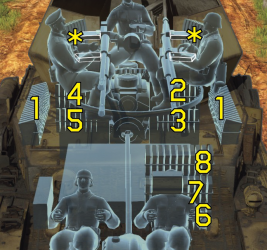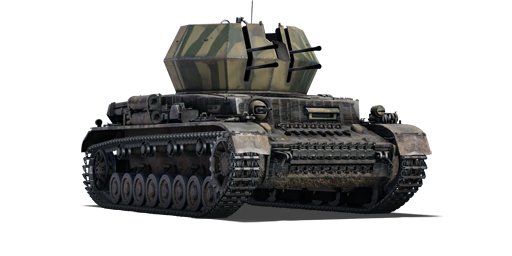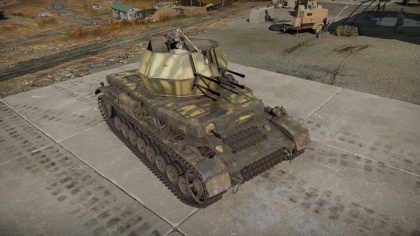Difference between revisions of "Wirbelwind"
(→Usage in the battles) (Tag: Visual edit) |
(→Pros and cons) (Tag: Visual edit) |
||
| Line 237: | Line 237: | ||
* Extreme fire rate, compared to other SPAA | * Extreme fire rate, compared to other SPAA | ||
* Excellent armour for an AA vehicle | * Excellent armour for an AA vehicle | ||
| − | |||
* High driving speed able to move from cover to cover with little to no problem. | * High driving speed able to move from cover to cover with little to no problem. | ||
Revision as of 04:26, 20 May 2019
Contents
Description
The Flakpanzer IV Wirbelwind is a Rank III German self-propelled anti-aircraft gun
with a battle rating of 4.7 (AB) and 3.7 (RB/SB). It was introduced in Update 1.43.
The Flakpanzer IV Wirbelwind is a anti-aircraft platform on a Panzer IV chassis. Armed with quad 20mm FlaK38 cannons, this machine will absolutely obliterate any enemy plane that's unfortunate enough to cross paths with it. Due to the high fire rate, this machine effectively spews out a river of high exlposives. Any airplane unfortunate enough to even touch that stream will at least burst into flames, if not more severe damage. However, they are incredibly easy to spot because of the tracers. While an individual 20mm shell does not do much damage, it is very hard when using the Wirbelwind to hit an aircraft with only one shell. The sheer number of shells will overwhelm the aircraft, and act like a laser, cutting off pieces and burning others.
General info
Survivability and armour
Armour type:
- Rolled homogeneous armour
| Armour | Front | Sides | Rear | Roof |
|---|---|---|---|---|
| Hull | 80 mm (11°) Front plate 20 mm (72°) Front glacis 80 mm (11-12°) Lower glacis |
30 mm | 30 mm (4-15°) | 10 mm |
| Turret | 16 mm (19-24°) | 16 mm (21-27°) | 16 mm (17-22°) | N/A |
Notes:
- Suspension wheels are 15 mm thick and tracks are 20 mm thick.
- Some track links are placed on the front glacis, adding 15 mm armour at their area.
- Belly armour is 10 mm thick.
Mobility
| Mobility characteristic | ||
|---|---|---|
| Weight (tons) | Add-on Armor weight (tons) |
Max speed (km/h) |
| 25.0 | N/A | 42 (AB) |
| 39 (RB/SB) | ||
| Engine power (horsepower) | ||
| Mode | Stock | Upgraded |
| Arcade | 426 | 525 |
| Realistic/Simulator | 265 | 300 |
| Power-to-weight ratio (hp/ton) | ||
| Mode | Stock | Upgraded |
| Arcade | 17.04 | 21.00 |
| Realistic/Simulator | 10.60 | 12.00 |
Armaments
| 20 mm FlaK 38 (x4) | |||||
|---|---|---|---|---|---|
| Capacity (Belt capacity each) | Fire rate (shots/minute) |
Vertical guidance |
Horizontal guidance | ||
| 480 (20) | 480 | -10°/+90° | ±180° | ||
| Turret rotation speed (°/s) | |||||
| Mode | Stock | Upgraded | Prior + Full crew | Prior + Expert qualif. | Prior + Ace qualif. |
| Arcade | 35.7 | 49.4 | __.__ | __.__ | __.__ |
| Realistic | 35.7 | 42.0 | __.__ | __.__ | __.__ |
| Reloading rate (seconds) | |||||
| Stock | Prior + Full crew | Prior + Expert qualif. | Prior + Ace qualif. | ||
| 5.2 | __.__ | __.__ | __.__ | ||
Ammunition
| Penetration statistics | |||||||
|---|---|---|---|---|---|---|---|
| Ammunition | Type of warhead |
Penetration in mm @ 90° | |||||
| 10m | 100m | 500m | 1000m | 1500m | 2000m | ||
| PzGr | API-T | 46 | 45 | 33 | 23 | 15 | 11 |
| PzGr 40 | HVAP-T | 64 | 63 | 33 | 23 | 15 | 11 |
| Sprgr. | HEFI-T | 2 | 2 | 2 | 2 | 2 | 2 |
| Shell details | ||||||||||
|---|---|---|---|---|---|---|---|---|---|---|
| Ammunition | Type of warhead |
Velocity in m/s |
Projectile Mass in kg |
Fuse delay
in m: |
Fuse sensitivity
in mm: |
Explosive Mass in g (TNT equivalent): |
Normalization At 30° from horizontal: |
Ricochet: | ||
| 0% | 50% | 100% | ||||||||
| PzGr | API-T | 780 | 0.15 | N/A | N/A | N/A | -1° | 47° | 60° | 65° |
| PzGr 40 | HVAP-T | N/A | N/A | N/A | N/A | N/A | N/A | N/A | N/A | |
| Sprgr. | HEFI-T | 900 | 0.12 | 0.3 | 0.1 | 10.2 | +0° | 62° | 69° | 73° |
Belt types
| Belts | Shell composition | Combat usage |
| Default | API-T, HEFI-T (Armour Piercing Incendiary tracer – High Explosive Fragmentation Incendiary tracer) shell |
50% of this belt are useless against tanks or planes. However against other SPAA this belt can reliably take out crew, armament, ammo and engine. Having one belt in reserve does not hurt. |
| Sprgr. | HEFI-T (High Explosive Fragmentation Incendiary tracer) shell |
Versus planes and open combat compartment vehicles. Aircraft will usually take three to six hits. Heavy armoured attackers and bombers may require more though. |
| PzGr | API-T (Armour Piercing Incendiary tracer) shell |
Intermediate usage until the better PzGr 40 can be used. Decent enough versus light tanks and other vehicles from the rear. Due the lack of HE filler underwhelming damage, yet still better than the PzGr 40. |
| PzGr 40 | HVAP-T, API-T (High Velocity Armour Piercing tracer - Armour Piercing Incendiary tracer) shell |
Best penetrating shell of this vehicle. However, the damage effects are very poor. In close combat snipe for modules and crewmember for increased survival rate. Nothing is more annoying than emptying a clip and then to get destroyed in the reload because the enemy gunner survived. Against angled armoured it is not very effective like any other ACPR shell, this is offset by the very high base penetration though. |
Ammo racks

| Full ammo |
1st rack empty |
2nd rack empty |
3rd rack empty |
4th rack empty |
5th rack empty |
6th rack empty |
7th rack empty |
8th rack empty |
Visual discrepancy |
|---|---|---|---|---|---|---|---|---|---|
| 160 | 36 (+128) | 32 (+128) | 24 (+136) | 20 (+140) | 16 (+144) | 12 (+148) | 8 (+152) | 0 (+160) | Yes |
Clips with 20 rounds each (3,200 rounds max)
*Ammunition clips in turret do not empty
Usage in the battles
Anti-Aircraft -
unfortunately, this is where SPAA tend to not be nearly as effective against ground forces, but also see marked improvement in their intended role as CAS counter and deterrent.
to that end, your 4x20mm automatic cannons give you the ability to fire a lethal stream of explosive round at any pilot who wanders into your sights.
while in tank guns dispersion (the MOA cone that is used to determine accuracy) is something that is ideally kept to a minimum, this vehicle benefits from it by having shots spread out in a sort of "shotgun" effect, rather than having 4 seperate beams of projectiles. this means that if you can get your lead point right, your odds of shredding aircraft with even a momentary burst is exceptional compared to other types of AA present at the ranks that you will be operating this vehicle.
rather unfortunately, you only have 20 rounds per gun (for a total of 80), meaning that it is best to fire 3-5 round bursts, to make effective use of what ammunition you have and your magazine size. this is one of the few areas the wirbelwind is caught lacking, the others being an open crew compartment roof and the fact that your SPAA houses most of it's crew in a thinly armored turret.
Other -
so, this is where it's performance tapers off a cliff.
while you do have access to APCR/Pzgr.40 belts, they are largely useless against medium and heavy tanks, which become very numerous at 3.7BR.
you can definitely take out light tanks, but if you are playing as a SPAA and even see enemy tanks, your team is likely about to be spawncamped, and you are really only able to generate SL from hitting enemy tanks.
in summary - if you are not using this as a SPAA, you are not enjoying this vehicle to it's full potential. it's a SPAA, end of story.
Modules
Tier 1: Spr.Gr. (new HE belts) -> Parts (for repairs) -> Turet drive (faster turn rate)
Tier 2: FPE (fire extinguisher) -> plus something of desire Adjustment of fire is not recommended with 1800rpm. Spray a minefield!
Tier 3: Elevation mechanism (faster barrel raise) -> Anything else
Everything else can be researched at leisure.
Pros and cons
Pros:
- High rate of fire (1800 rounds per minute combined!)
- Impressive ammo capacity of 3200 rounds / 2 minutes of fire
- Will devastate planes at close range
- Excellent turret traverse make it possible to stay on aircraft
- Extreme fire rate, compared to other SPAA
- Excellent armour for an AA vehicle
- High driving speed able to move from cover to cover with little to no problem.
Cons:
- Open top design makes vehicle vulnerable to strafing runs by enemy aircraft
- Hexagonal turret susceptible to HE rounds
- Less effective at firing at distant aircraft
- Reloading rate sub-par compared to other SPAAs at 5.6 seconds
- With continuous firing, a magazine is emptied very fast
- 20mm shells have difficulty dealing with bombers due to both durability and average alltitude of targets
- Weak side armour, where an ammo rack is located
History
Development
Development of self-propelled anti-aircraft guns that could keep up with the Panzer formations were not taken into consideration in the early years of World War II due to the Luftwaffe's superiority over the air, but gradual losses in the Luftwaffe and inability to support their flights gave the Allies the upper hand in the air, granting them air superiority. The growing air power of the Allies forced the Germans to develop methods to protect their tank formations from strafing from Allied aircraft, one early design to protect the front line tanks was the Flakpanzer IV Mobelwagen, an interim design as Flakpanzer designs underwent development. SS-Hauptsturmführer Karl Wilhelm Krause of the 12th SS Panzer Division came up with the concept of the Flakpanzer IV Wirbelwind in the summer of 1944. The commander of the 12th SS Panzer Regiment, SS-Obersturmbannführer Max Wünsche, received this and presented it to Hitler, to which he approved for its development.
The design called for use of the proven Panzer IV design. The Wirbelwind uses the Panzer IV hull, but the original Panzer IV turret was removed and replaced with a open-topped nine-sided turret that mounted the anti-aircraft armament. The anti-aircraft armament chosen for the vehicle was a quadruple mounted 2 cm FlaK 38. Though a closed-top turret design was desired, the amount of gasses given out by the gun made this impossible for the crew. The production of the Wirbelwind commenced at the Ostbau Werke at Sagan, Silesia. Between 87 to 105 Wirbelwinds were manufactured from May to November 1944, with the discrepancies due to differences in the Wehrmacht service records and Ostbau Werke's production records.
Combat usage
The troops nicknamed the Wirbelwind the "Keksdose" (Biscuit Tin) due to its unique turret shape. The Wirbelwind were equipped with Panzer formations to protect them against low-flying aircraft. During the Battle of Normandy in 1944, flak units in the 12th SS Panzer Division was credited with shooting down 45 allied planes. However, there weren't enough to go around in the front-lines so many Panzer formations were left vulnerable to enemy aircraft due to lack of availability of the Flakpanzers. Not only did their small numbers made their effect on the front minimal, the 20 mm cannon was determined to insufficient against the more armoured aircraft that the Allies are fielding. Thus, the design was changed to not use the quadruple 2 cm Flak 38, but instead the 3.7 cm FlaK 43 in the new designation Flakpanzer IV Ostwind. Aside from that the Wirbelwind also served as a ground support role, which it proved very well at with its rapid firing 20 mm cannons.
It was determined that the Flakpanzer IV in the Wirbelwind and Ostwind configurations were to be replaced by the Kugelblitz by early 1945, in an attempt to yet again increase the firepower of the anti-aircraft guns. But this never happened due to the war ending before the Kugelblitz could be deployed.
Media
Skins and camouflages for the Wirbelwind.
Read also
Links to the articles on the War Thunder Wiki that you think will be useful for the reader, for example,
- reference to the series of the vehicles;
- links to approximate analogues of other nations and research trees.
ETC.
Sources
Paste links to sources and external resources, such as:
- topic on the official game forum;
- other literature.
| Germany anti-aircraft vehicles | |
|---|---|
| Wheeled | Sd.Kfz.222 |
| Half-track | Sd.Kfz.251/21 · Sd.Kfz. 6/2 |
| Flakpanzer IV | Wirbelwind · Ostwind · Ostwind II · Kugelblitz · Zerstörer 45 |
| Other Flakpanzers | Flakpanzer I · Flakpanzer 38 · Flakpanzer 341 |
| Wiesel AWC | Wiesel 1A4 · Ozelot |
| Radar SPAAG | Gepard · Gepard 1A2 |
| Missile SPAA | FlaRakPz 1 · FlaRakRad |





